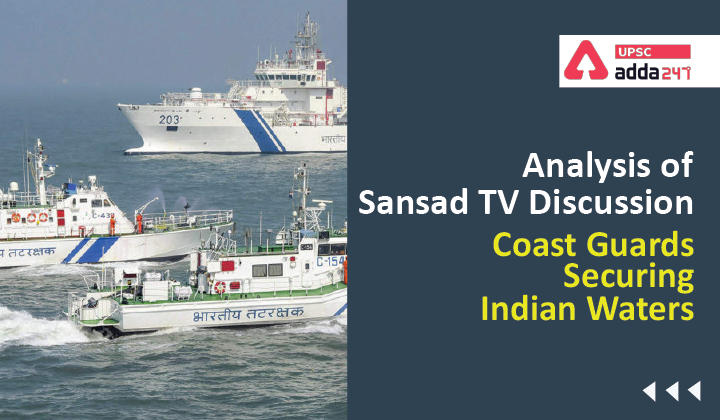Table of Contents
Context
- V.S. Pathania took over as the 24th Director General (DG) of the Indian Coast Guard on December 31 from Krishnaswamy Natarajan who retired from service.
- Mr Pathania is the recipient of the President’s Tatrakshak Medal for Distinguished Service.
About Indian Coast Guard
- Motto: “VAYAM RAKSHAMAH” – WE PROTECT
- The Indian Coast Guard is a multi-mission organization, conducting round-the-year real-life operations at sea.
- Despite being relatively small, it has a wide range of task capabilities for both surface and air operations.
- It comes under the Ministry of Defence.
- It has jurisdiction over the territorial waters of India including contiguous zone and Exclusive Economic Zone (EEZ).
Role of DGICG
- The organization is headed by the Director-General Indian Coast Guard (DGICG) exercising his overall command and superintendence from the Coast Guard Headquarters (CGHQ) located at New Delhi.
- At CGHQ, he is assisted by four Deputy Director Generals of the rank of Inspector General, and other senior officers heading various staff divisions.
What is the Mission of ICG?
- To protect our ocean and offshore wealth including oil, fish and minerals.
- To assist mariners in distress and safeguard life and property at sea.
- To enforce maritime laws with respect to sea, poaching, smuggling and narcotics.
- To preserve the marine environment and ecology and protect rare species.
- To collect scientific data and back up the navy during the war.
Which are Coast Guard Regions?
- For effective command and control, the Maritime Zones of India are divided into five Coast Guard Regions, namely, North-West, West, East, North-East and Andaman & Nicobar, with the respective Regional Headquarters located at Gandhinagar, Mumbai, Chennai, Kolkata and Port Blair.
- The Coast Guard Regions are commanded by Officers of the rank of Inspector General.
- The regions are further divided into twelve Coast Guard ‘Districts’, one each for the nine coastal states on the mainland, two in the Andaman & Nicobar Region, and one at Kavaratti in the Lakshadweep and Minicoy Islands.
- Each Coast Guard District comprises one or more Coast Guard Stations.
- In addition, there are Coast Guard Air Stations (CGAS) and Air Enclaves (CGAE) for air operations from various locations along the coastline.
What is the Charter of Duties of ICG?
- Safety and Protection of Artificial Islands and Offshore Terminals
- Protection of Fishermen
- Assistance to Fishermen in Distress at Sea
- Preservation and Protection of Marine Environment
- Prevention and Control of Marine Pollution
- Assisting the Customs and other authorities in anti-smuggling operations
- Enforcement of Maritime Laws in Force
- Safety of Life and Property at Sea
- Collection of Scientific Data
What is Tatrakshak Medal?
The TM is awarded for acts of conspicuous gallantry and valuable service characterised by resourcefulness and devotion to duty including prolonged service of ability and merit.
History of Making of Indian Coast Guard?
- Ever since the 1960s, the Indian Navy had been requesting the Government of India for setting up an auxiliary service for Maritime Law Enforcement and undertaking “Safety and Protection” tasks in Indian waters.
- Deployment of sophisticated and high-value naval warships and assets was clearly not an optimal alternative for these tasks.
- In due course, this logic of the Navy was accepted by the Government, especially due to the fact that by the early 1970’s, three other important factors contributed to the rationale for the early institution of a ‘Coast Guard’ service.
- Sea-borne smuggling across the seas was rampant and threatened the nation’s economy. The existing maritime agencies such as the Customs and the Fisheries Department did not have the capability to contain this large scale smuggling activity and intercept illegal vessels even within territorial waters.
- Against this backdrop, the ‘Nag Committee’ was setup in 1970, to examine the growing menace of smuggling. The committee recommended the need for a separate marine force to deal with smuggling activities.
- In 1972, the United Nations Convention on the Laws of the Sea (UNCLOS) awarded Exclusive Economic Zones (EEZ) to all coastal states.
- Thereafter, the Union of India, enacted the Maritime Zones of India Act 1976, to claim sovereign rights over the vast sea area of the Exclusive Economic Zone.
- In one stroke, India acquired 2.01 million sq km of the ocean for extensive exploitation of all living and non-living resources, and this vast area clearly needed to be policed.
- ICG was established in August 1978 by the Coast Guard Act, 1978 as an independent Armed force of India



 TSPSC Group 1 Question Paper 2024, Downl...
TSPSC Group 1 Question Paper 2024, Downl...
 TSPSC Group 1 Answer key 2024 Out, Downl...
TSPSC Group 1 Answer key 2024 Out, Downl...
 UPSC Prelims 2024 Question Paper, Downlo...
UPSC Prelims 2024 Question Paper, Downlo...
